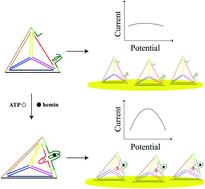当前位置:
X-MOL 学术
›
Anal. Methods
›
论文详情
Our official English website, www.x-mol.net, welcomes your feedback! (Note: you will need to create a separate account there.)
An electrochemical aptasensor for ATP based on a configuration-switchable tetrahedral DNA nanostructure.
Analytical Methods ( IF 3.1 ) Pub Date : 2020-05-26 , DOI: 10.1039/d0ay00431f Cheng Jing 1 , Haohan Chen 1 , Rongfeng Cai 1 , Yaping Tian 1 , Nandi Zhou 1
Analytical Methods ( IF 3.1 ) Pub Date : 2020-05-26 , DOI: 10.1039/d0ay00431f Cheng Jing 1 , Haohan Chen 1 , Rongfeng Cai 1 , Yaping Tian 1 , Nandi Zhou 1
Affiliation

|
A novel electrochemical aptasensor for ATP was developed based on an aptamer-embedded configuration-switchable tetrahedral DNA nanostructure (TDN) and the formation of a G-quadruplex. This unique TDN was formed through the self-assembly of four specially designed single-stranded DNA (ssDNA) sequences (S1, S2, S3 and S4). The TDN was immobilized on the surface of a Au electrode through the thiol groups at the 5′-end of S1, S2 and S3. Five edges of the TDN were designed to form a double helix to preserve the structural robustness of the tetrahedron, while the ATP aptamer embedded sequence (S3) was designed to be located at the rest edge. The two terminals of S4 at the same edge were composed of two split G-quadruplex-forming sequences, which were non-complementary to the aptamer. This edge offered the configuration-switchable characteristic of the TDN. In the absence of ATP, the TDN remained in a relaxed state, and the G-quadruplex cannot form due to the large distance between the split G-quadruplex-forming sequences. However, in the presence of ATP, the aptamer combined with ATP and shortened the distance between the split sequences, resulting in the taut state of the TDN and the formation of a G-quadruplex at the edge. After the addition of hemin, the differential pulse voltammograms (DPVs) were used to quantify ATP. The sensor revealed a dynamic response range from 0.1 nM to 1 μM, with a detection limit of 50 pM. In addition, the specificity and practicability in real samples were also verified, indicating its potential applications.
中文翻译:

基于结构可切换的四面体DNA纳米结构的ATP电化学适体传感器。
基于适体嵌入的结构可切换的四面体DNA纳米结构(TDN)和G四联体的形成,开发了一种新型的ATP电化学传感器。这种独特的TDN是通过四个特殊设计的单链DNA(ssDNA)序列(S1,S2,S3和S4)的自组装形成的。TDN通过S1,S2和S3的5'端的硫醇基团固定在Au电极的表面上。TDN的五个边缘设计为形成双螺旋,以保留四面体的结构坚固性,而ATP适体嵌入序列(S3)设计为位于其余边缘。S4在同一边缘的两个末端由两个分裂的G-四链体形成序列组成,它们与适体不互补。该边缘提供了TDN的可配置切换的特性。在缺少ATP的情况下,TDN保持松弛状态,由于分裂的G-四链体形成序列之间的距离较大,因此无法形成G-四链体。但是,在存在ATP的情况下,适体与ATP结合并缩短了分裂序列之间的距离,导致TDN处于拉紧状态,并在边缘形成了G-四链体。加入血红素后,使用差分脉冲伏安图(DPV)定量ATP。该传感器的动态响应范围为0.1 nM至1μM,检测极限为50 pM。此外,还验证了在真实样品中的特异性和实用性,表明了其潜在的应用前景。由于分裂的G-四链体形成序列之间的距离较大,因此无法形成G-四链体。但是,在存在ATP的情况下,适体与ATP结合并缩短了分裂序列之间的距离,导致TDN处于拉紧状态,并在边缘形成了G-四链体。加入血红素后,使用差分脉冲伏安图(DPV)定量ATP。该传感器的动态响应范围为0.1 nM至1μM,检测极限为50 pM。此外,还验证了在真实样品中的特异性和实用性,表明了其潜在的应用前景。由于分裂的G-四链体形成序列之间的距离较大,因此无法形成G-四链体。但是,在存在ATP的情况下,适体与ATP结合并缩短了分裂序列之间的距离,导致TDN处于拉紧状态,并在边缘形成了G-四链体。加入血红素后,使用差分脉冲伏安图(DPV)定量ATP。该传感器的动态响应范围为0.1 nM至1μM,检测极限为50 pM。此外,还验证了在真实样品中的特异性和实用性,表明了其潜在的应用前景。导致TDN处于拉紧状态,并在边缘形成G四联体。加入血红素后,使用差分脉冲伏安图(DPV)定量ATP。该传感器的动态响应范围为0.1 nM至1μM,检测极限为50 pM。此外,还验证了在真实样品中的特异性和实用性,表明了其潜在的应用前景。导致TDN处于拉紧状态,并在边缘形成G四联体。加入血红素后,使用差分脉冲伏安图(DPV)定量ATP。该传感器的动态响应范围为0.1 nM至1μM,检测极限为50 pM。此外,还验证了在真实样品中的特异性和实用性,表明了其潜在的应用前景。
更新日期:2020-07-02
中文翻译:

基于结构可切换的四面体DNA纳米结构的ATP电化学适体传感器。
基于适体嵌入的结构可切换的四面体DNA纳米结构(TDN)和G四联体的形成,开发了一种新型的ATP电化学传感器。这种独特的TDN是通过四个特殊设计的单链DNA(ssDNA)序列(S1,S2,S3和S4)的自组装形成的。TDN通过S1,S2和S3的5'端的硫醇基团固定在Au电极的表面上。TDN的五个边缘设计为形成双螺旋,以保留四面体的结构坚固性,而ATP适体嵌入序列(S3)设计为位于其余边缘。S4在同一边缘的两个末端由两个分裂的G-四链体形成序列组成,它们与适体不互补。该边缘提供了TDN的可配置切换的特性。在缺少ATP的情况下,TDN保持松弛状态,由于分裂的G-四链体形成序列之间的距离较大,因此无法形成G-四链体。但是,在存在ATP的情况下,适体与ATP结合并缩短了分裂序列之间的距离,导致TDN处于拉紧状态,并在边缘形成了G-四链体。加入血红素后,使用差分脉冲伏安图(DPV)定量ATP。该传感器的动态响应范围为0.1 nM至1μM,检测极限为50 pM。此外,还验证了在真实样品中的特异性和实用性,表明了其潜在的应用前景。由于分裂的G-四链体形成序列之间的距离较大,因此无法形成G-四链体。但是,在存在ATP的情况下,适体与ATP结合并缩短了分裂序列之间的距离,导致TDN处于拉紧状态,并在边缘形成了G-四链体。加入血红素后,使用差分脉冲伏安图(DPV)定量ATP。该传感器的动态响应范围为0.1 nM至1μM,检测极限为50 pM。此外,还验证了在真实样品中的特异性和实用性,表明了其潜在的应用前景。由于分裂的G-四链体形成序列之间的距离较大,因此无法形成G-四链体。但是,在存在ATP的情况下,适体与ATP结合并缩短了分裂序列之间的距离,导致TDN处于拉紧状态,并在边缘形成了G-四链体。加入血红素后,使用差分脉冲伏安图(DPV)定量ATP。该传感器的动态响应范围为0.1 nM至1μM,检测极限为50 pM。此外,还验证了在真实样品中的特异性和实用性,表明了其潜在的应用前景。导致TDN处于拉紧状态,并在边缘形成G四联体。加入血红素后,使用差分脉冲伏安图(DPV)定量ATP。该传感器的动态响应范围为0.1 nM至1μM,检测极限为50 pM。此外,还验证了在真实样品中的特异性和实用性,表明了其潜在的应用前景。导致TDN处于拉紧状态,并在边缘形成G四联体。加入血红素后,使用差分脉冲伏安图(DPV)定量ATP。该传感器的动态响应范围为0.1 nM至1μM,检测极限为50 pM。此外,还验证了在真实样品中的特异性和实用性,表明了其潜在的应用前景。



























 京公网安备 11010802027423号
京公网安备 11010802027423号